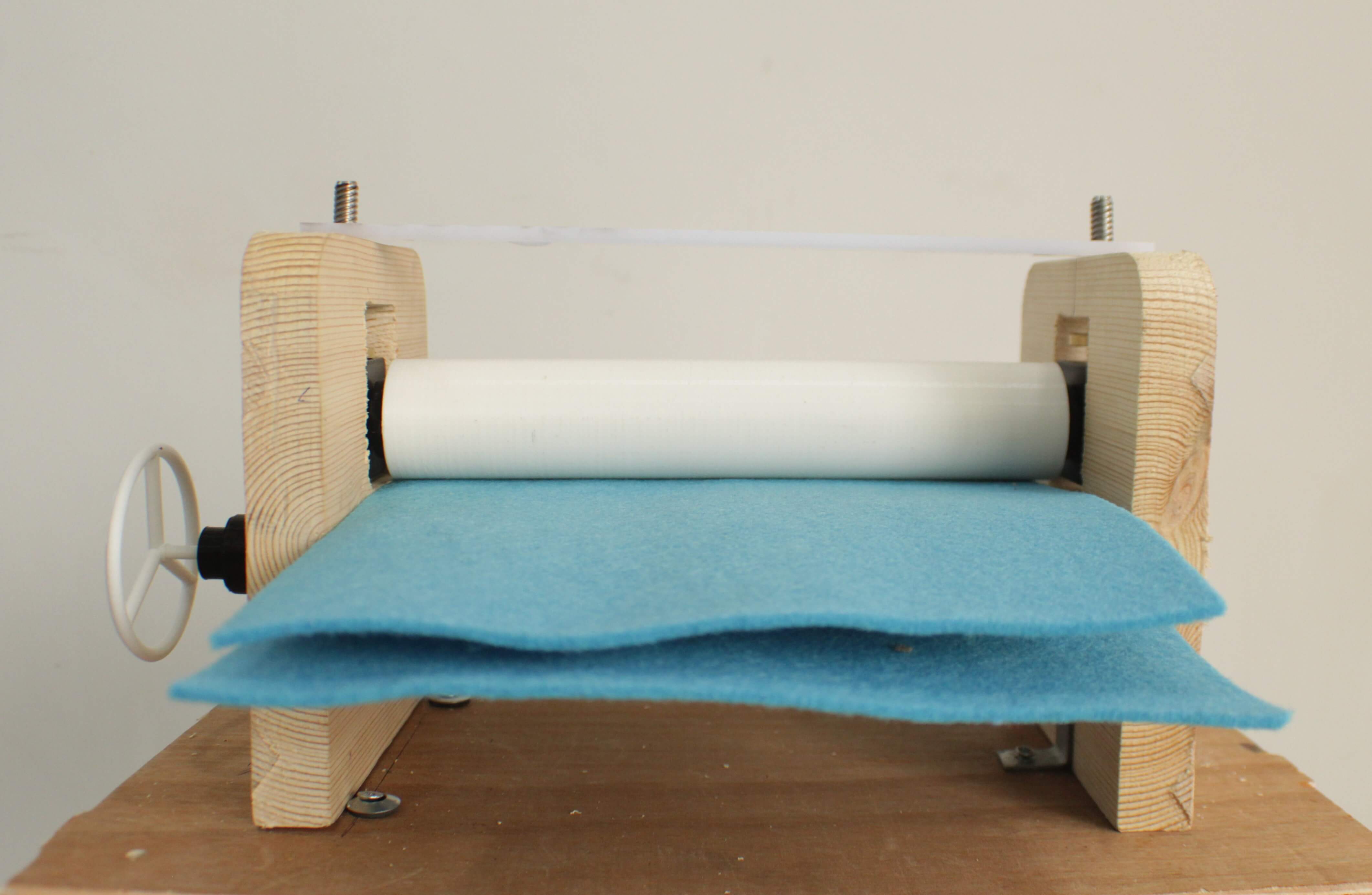10. Open Source Hardware¶
This week we were asked to work together as a team to build a machine using digital fabrication and open source platforms, and we decided to build a printing press machine, because we thought it can have many different applications, on the biochromes week we tried to give our fabrics some prints manually and it was very difficult so we thought this can help, plus printmaking is fun so we can experiment curving materials and print them
Printing Press Machine¶
References & Inspiration¶
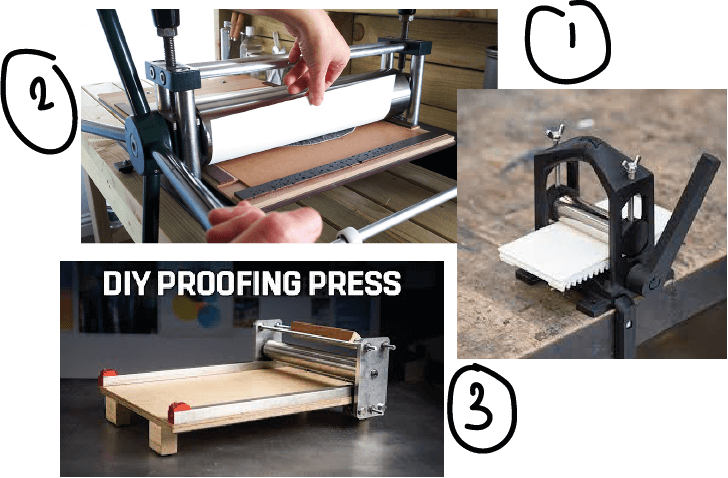
Credits:
Research¶
A printing press is basically a sandwich of the medium you want to print or emboss and a stamp that gets pressed between a roller and a flat surface. We looked into different presses to understand how the machine works and what to consider when designing one.
Mind Mapping¶
We used a shared Miro board to put our ideas together so each one of us can edit, add or change anything
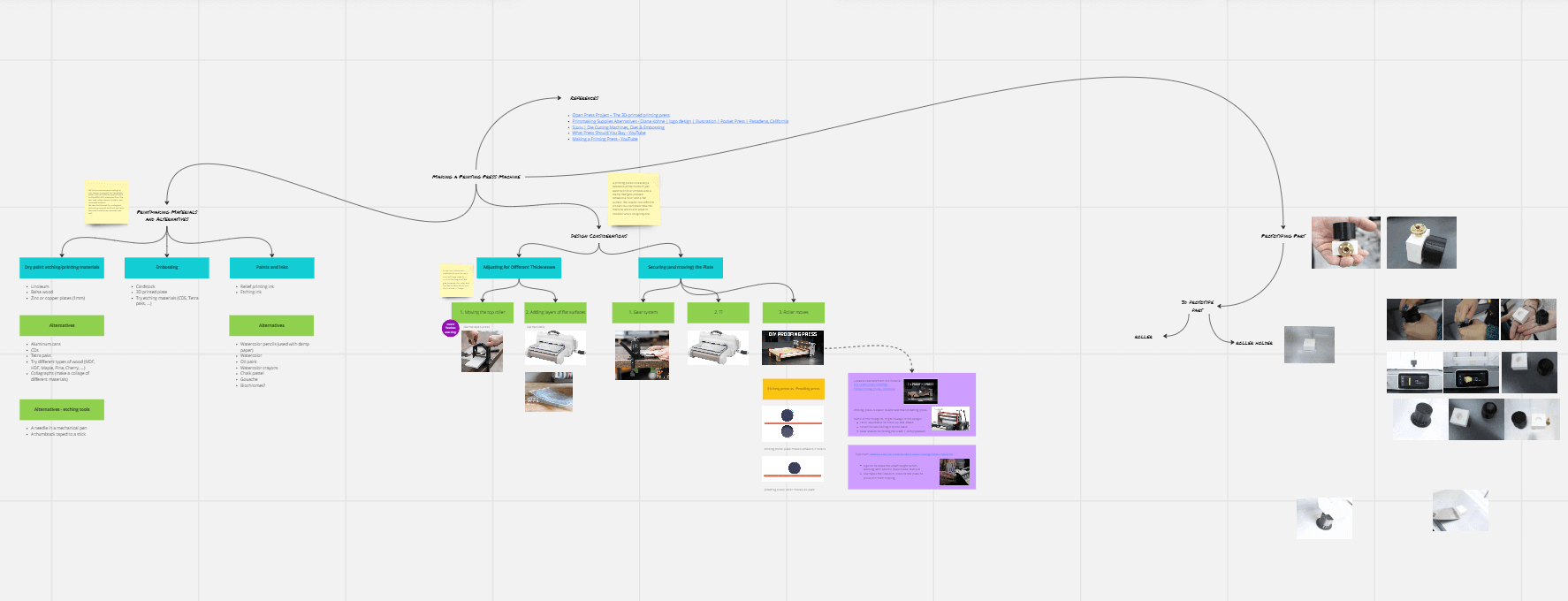
Design Considerations¶
In order to make a new design you need to think the design before starting, the mechanism, tools, and features. and this is what we did here we did not start from scratch we used some open source platformers to help us start, we watched videos, read some studies and saw some designs to be able to build our own machine they are all linked in the end of the documentation
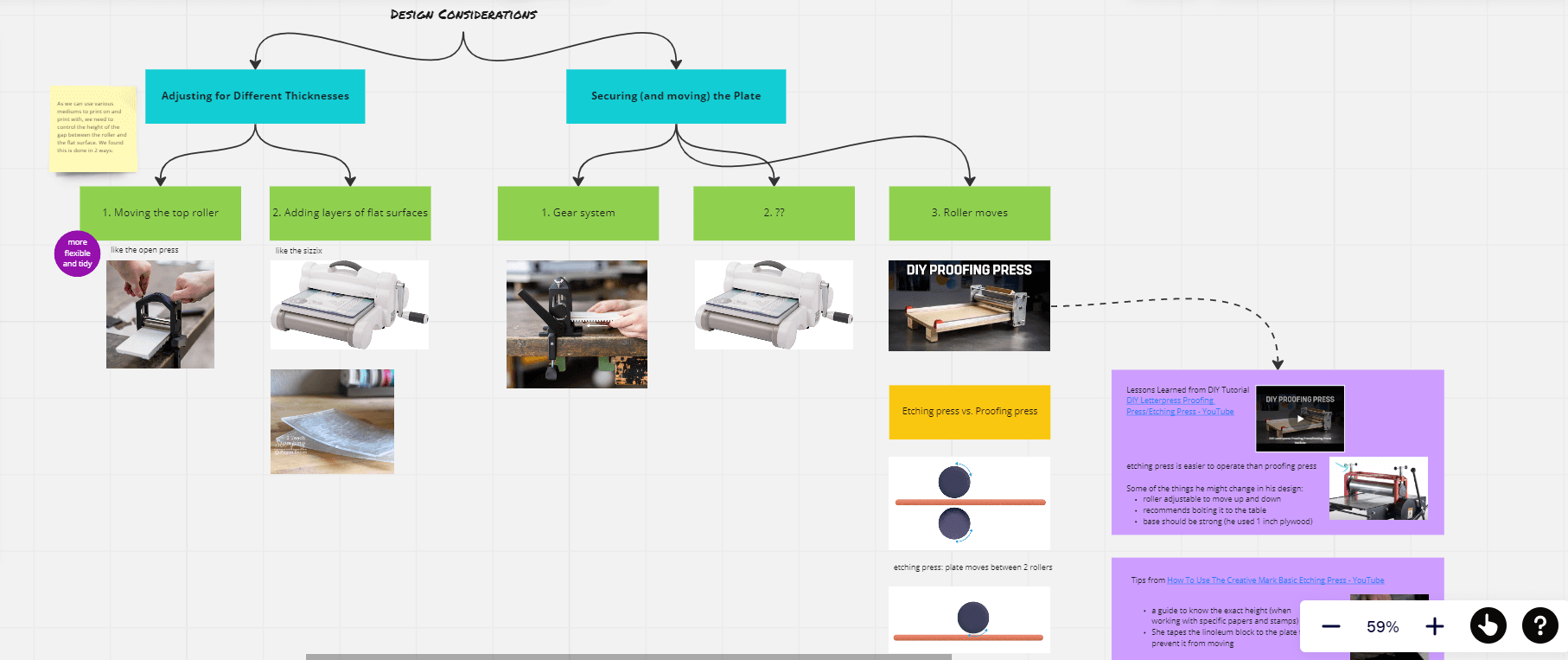
Etching VS. Proofing¶
We had two options for the mechanism:
- proofing press: roller moves on plate

- etching press: plate moves between 2 rollers
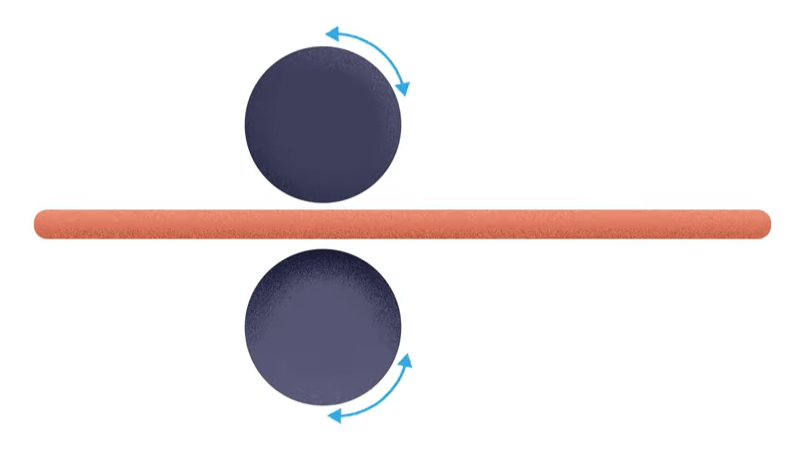
We decided on Etching press because etching press is easier to operate than proofing press
Why Is Our Design Special¶
- It is adjustable
- Easy to assemble
- Portable
- Affordable
- minimal
- customizable
- open source
Print Making Materials and Alternatives¶
As we can use various mediums to print on and print with
Dry point etching/printing materials
- Linoleum
- Balsa wood
- Zinc or copper plates (1mm)
Alternatives
- Aluminum cans
- CDs
- Tetra packs
- Try different types of wood (MDF, HDF, Maple, Pine, Cherry, ...)
- Collagraphs (make a collage of different materials)
Embossing
- Cardstock
- 3D printed plate
- Try etching materials (CDS, Tetra packs, ...)
Alternatives - etching tools
- A needle in a mechanical pen
- A thumbtack taped to a stick
Paints and inks
- Relief printing ink
- Etching ink
Alternatives
- Watercolor pencils (used with damp paper)
- Watercolor
- Oil paint
- Watercolor crayons
- Chalk pastel
- Gouache
- Biochromes
Ink Making¶
We were planning to have a kit with bio-based inks and recipes with the machine. That didn't happen as it needed more time for experiments and developing the best ink recipes. But we had a lot of fun experimenting with alternative printmaking techniques and bio-based inks. I tried to make ink using Arabic Gum as a binder and charcoal as a dye.
Recipe
-
Dye stuff: charcoal
-
Solvent: 2 Cups Water
-
Arabic gum: I Cup

Tools¶
* Glass Jar
* Wooden Stick
* Roller brush
* Scale
* Coffee Filters
* Acrylic board
* Dye Stuff
* Pipettes / Syringes
* Test tubes
* Petri dishes
* paper cups
* Solvents ( water / Alcohol )
* Paper
Some Prints We Made¶

Experiments¶
We stared by experimenting the very traditional wat of printing, putting a stamp in ink and use your hand to put pressure on it to be printed on a piece of paper, and it works perfectly if you put enough pressure but it takes a lot of effort and time

Then we tried another way to print using a rolling pin it makes the process a bit easier in terms of pressure but still needs a lot of time and have a larg error margins
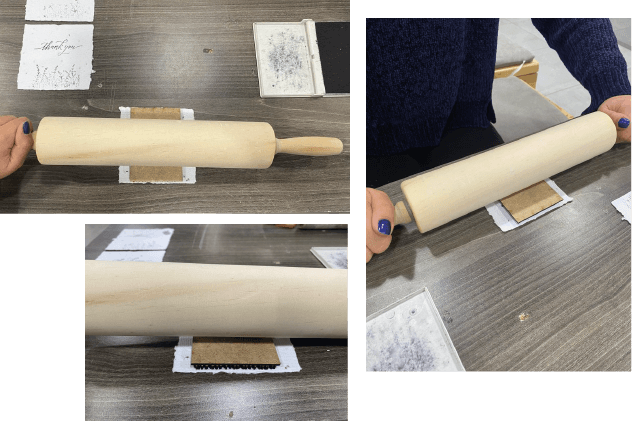
To understand the mechanism better we used the pasta making machine to print on a paper using a stamp and it worked perfectly, so we started building our first low fidelity prototype

(Low - Fidelity) Prototypes¶
Following the pasta making machine we built this prototype using to rolling pins and two bands

When we made sure it is working we upgraded the prototype to this, we laser cut the sides and the bottom, made holes according to the size of the rolling pin handles using drill

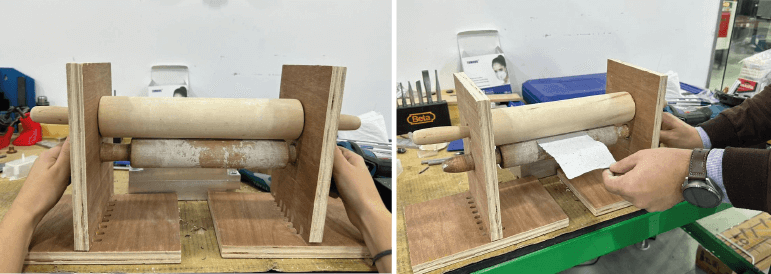
Fabrication Process¶
Designs¶

1) 2 Rollers¶
We used TPU Filament to print the roller because it is smoother and leaves no marks on the papers we are printing and is a bit flexible and can take more pressure than PLA
- Upper Roller

- Bottom Roller Bottom roller has the same design but a different connections
2) Roller Holders¶
The holders were 3D printed using PLA filament
- Upper Roller Holders

- Bottom Roller Holders
3) Handle¶
This handle and it's holders were 3D printed using PLA Filament

4) The lead screw¶
This 8mm * 100mm Lead screw was cut using a Metal cutting saw

5) Side Walls¶
We used the CNC Milling machine to cut the side walls, that are made out of 22mm plywood

6) Bed¶
The bed as well was cut using the CNC milling machine using 22mm Plywood

CNC mill settings
The CNC we have at the lab is a Shopbot.
To cut the 22mm plywood we used an endmill 1/4" (0.25 inch diameter) with 2 flutes
Tool Settings
Cutting Parameters: Pass Depth = 0.21 inch | Stepover =0.1 inch 40%
Feed and Speeds: Apindle Speed = 14000 rpm | Feed Rate = 1.8 inches/sec | Plunge Rate = 0.9 inches/sec | Chip Load 0.0039 inches
Toolpath Settings
Cuttind Depth = 24.5 mm
Passes = 7
Tool travels outside the path with Allowance Offset = 0.0 mm
Tab Options: Langth = 20 mm | Thickness = 10 mm | 3D tab
The most tricky part in the machine was this piece that should connect the rollers and allow them to move vertically to take different thicknesses of "sandwiches". (A sandwich is the group of layers we put between the ayers to make a print or a cut). This piece was not working at all in this prototype so we had to redesign it
Assembly¶

Final¶

3D Model¶
Machine Anatomy¶
| Parts | Quantity | Technology | Files | Notes |
|---|---|---|---|---|
| Body ( Structure ) | 2 | CNC Plywood Profiles | You can use any other material | |
| Feet ( Body Holders ) | 4 | 3D Printed PLA/ABS | - | |
| Roller Press | 2 | 3D Printed TPU | - | |
| Roller Holder | 4 | 3D Printed PLA\ABS | - | |
| Handel | 1 | 3D Printed PLA\ABS | - |
Printing Press 02 ( Rethinking the mechanism )¶
While we were proud of what we accomplished so far, we took a break and then we gave it another go, and it was then when we realized that the pressure coming from the rollers was as not good as we hoped it would be. The reason for that was the properties of the TPU, it's soft and somewhat elastic. That's why we decided to replace the 3D-printed rollers with metal ones that we found in the store. The rest of the parts and the process remained the same, here's a gif with the output

Since the tricky piece that was supposed to hold the rollers and allow them to move vertically was not working well, we had to rethink it. I made these sketches on the wall in the meeting room. I felt like those mad scientists we see in the movies
The Holder¶
For the holder piece to be able to move vertically and stay at its position, I had to think about the parts that should be able to rotate freely and the parts that should be fixed. I bought some screws and different types of bolts and tried different iterations to understand the movement. Then, I made a rapid prototype using a laser cutter, a screw, a bolt, and some tape. I did a few more prototypes as seen in the right photo.
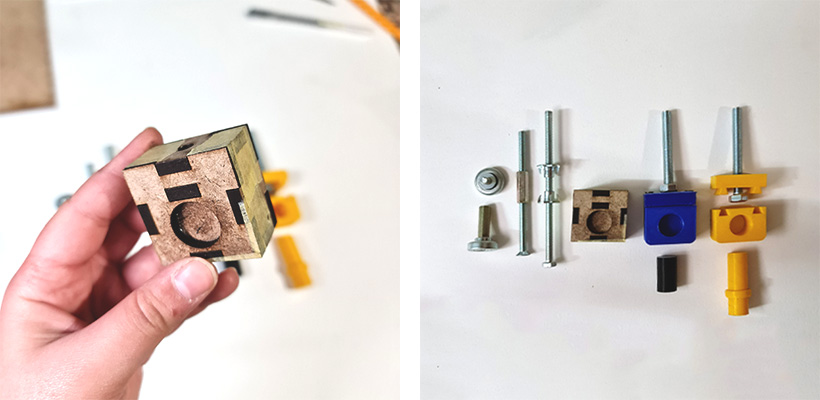
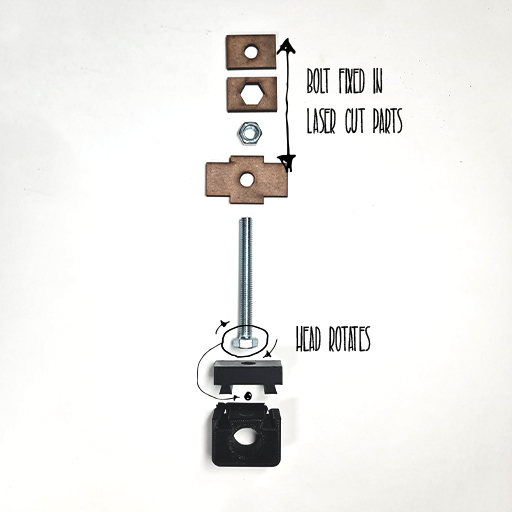
When I found everything working good, I made a -hopefully final- 3D printed prototype. We tested it in the machine. And it works!
The Body¶
Awesome. let's have a little look on how we made the body of the machine and put everything together. I started by taking the measurements from the first prototype and drawing some rectangles for the sides and roller holders on Rhino. Then I measured the roller's diameter and decided on their places. I wanted them to touch each other when the top roller is at its lowest point. Just in case we needed to print something extra thin. I took the measurements of the screw and bolt I bought to fit them properly in the design. You can see the screw and bolt drawn here as well
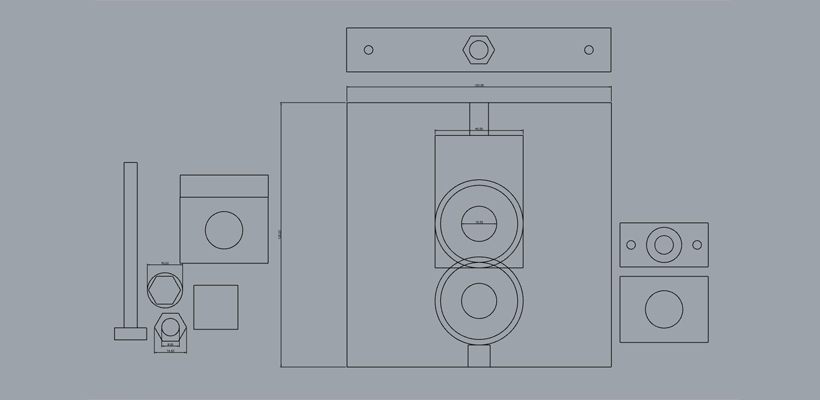
At some point, I decided to cut the pieces using the CNC milling machine so I made this quick model
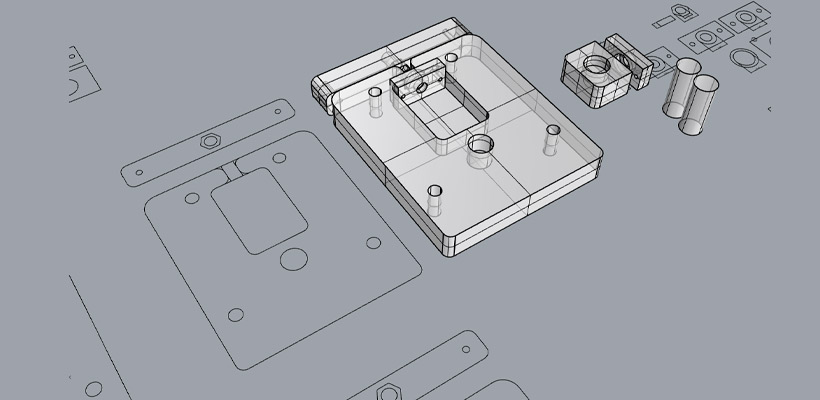 I then changed my mind. A CNC machine isn't available in every makerspace. It is much more expensive and difficult to operate. Making the pieces with a laser cutter seemed a more logical and user-friendly option. So I turned the design into these rectangles. On the image at the left I made an offset from the main rectangle to account for the material thickness to draw the fingers. You can also see little rectangles on the side. I made three layers of wood to hold the bolt in its place: the middle layer has a cut the shape of the bolt and the other two have circular openings the diameter of the screw. I drew these rectangles to calculate the height of the layers and where to put the openings to fit them into the main body
I then changed my mind. A CNC machine isn't available in every makerspace. It is much more expensive and difficult to operate. Making the pieces with a laser cutter seemed a more logical and user-friendly option. So I turned the design into these rectangles. On the image at the left I made an offset from the main rectangle to account for the material thickness to draw the fingers. You can also see little rectangles on the side. I made three layers of wood to hold the bolt in its place: the middle layer has a cut the shape of the bolt and the other two have circular openings the diameter of the screw. I drew these rectangles to calculate the height of the layers and where to put the openings to fit them into the main body
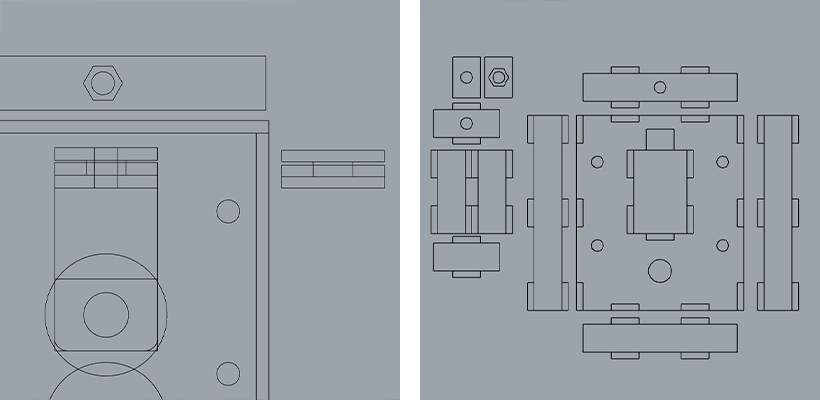
The Machine¶
And here it is! Our affordable, easy to fabricate and assemble printing press machine.
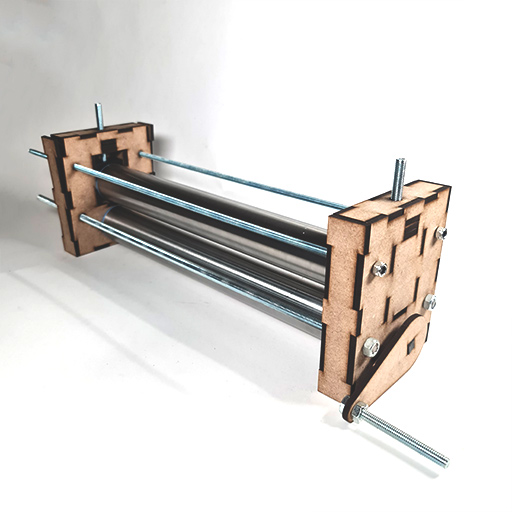
We tried to fit the pieces of the design on the board to reduce waste material as much as possible.
 Laser cut parts
Laser cut parts
Laser cut settings
we used mdf 4.7 mm as a material.
These are the laser settings for the Trotec speedy 400
Power: 100
Speed: 0.5
We exported the roller holder 3D model as .stl to Cura to print it. We printed it on Ultimaker S5 with 0.2 layer height. The cylinders go into the rollers. The one with the cube is to attach the arm to rotate the rollers.
 3D printed roller holder
3D printed roller holder
3D printing settings
Printer: Ultimaker S5
Layer height: 0.2 mm
Wall thickness: 0.8 mm
Top/bottom thickness: 0.8 mm
Infill: 15% triangles
A Gif of The Assembly¶

Equipment needed to replicate the machine¶
MACHINES¶
- 3D PRINTER FDM
- LASER CUTTER
- CNC MILLING MACHINE
TOOLS¶
- HAND DRILL
- CALIPER
- METER
- PENCIL / MARKER
Materials To Buy For The Low Fidelity Prototype¶
| Qty | Description | Price | Link | Notes |
|---|---|---|---|---|
| 1 | Print Making Ink | 17.00 $ | Link | You can find alternatives |
| 1 | Rolling pins | 19.50 $ | Link | - |
| 1 | plywood Board | 47.00 $ | Link | We Used plywood waste |
Materials To Buy For The first Machine¶
| Qty | Description | Price | Link | Notes |
|---|---|---|---|---|
| 1 | Print Making Ink | 17.00 $ | Link | You can find alternatives |
| 2 | Lead Screws\ Nuts | 14.99 $ | Link | - |
| 1 | PLA \ TPU Filaments | 15.99 $ - 27.99 $ | Link - Link | - |
Bill of Materials for the last edition¶
| Qty | Description | Price | Notes |
|---|---|---|---|
| 1 | mdf board 5mm | 6.00 $ | 60*22 cm is needed |
| 2 | dough roller | 6.00 $ | as wide as the size you want |
| 2 | screw D8mm 10cm | 0.25 $ | |
| 4 | screw bar 8mm | 1.00 $ | |
| 18 | bolt 8mm | 0.1 $ | |
| - | PLA filament | - |
Video¶
Fabricademy 22/23 Printing Press Machine from Ala Janbek on Vimeo.
This was Alaa trying the machine Alaa
